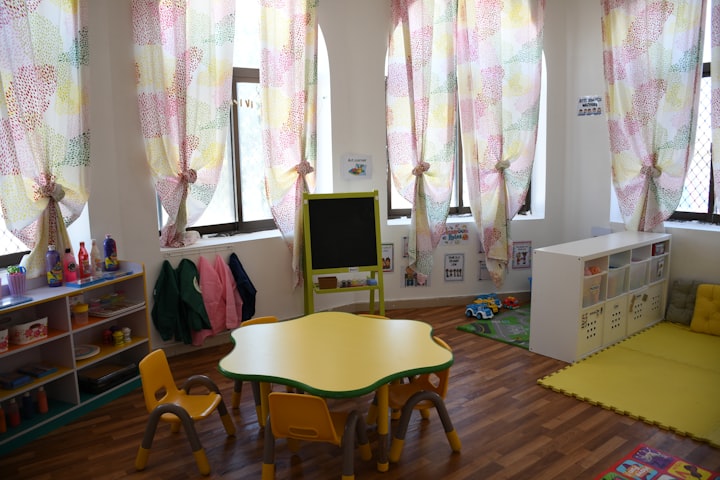Two College Students Escort Me Out of My First Grade Classroom
Just another day in my 1970s childhood

When I was in the first grade (or perhaps the second grade) sometime between 1973 and 1974, I attended a large public elementary school in the American Midwest. Located next door to an extension campus of a state university, we young students had unique access to the world of higher learning. By this I mean we could see hippie college students sitting on the grass playing guitars as we walked home from school.
The coolest thing for us grade-schoolers to do was “cut through campus”, walking the paths by the tall beige and grey college buildings with no adult supervision. I don’t know if our parents knew we did this at the time. There was no way for us to check in with them or vise versa. As long as we got home within the hour that school ended no one would worry.
What I didn’t realize at the time was that the college students used their proximity to the elementary school to their advantage just as much as we used their campus for fun and being “cool”. At least that seemed to be the case when college students began appearing at my classroom door at odd hours of the school day. They came every day for at least a week, two by two, asking our teacher if they could take each child away for a while, one at a time.
Our teacher would then point to a child and direct the college students over to one of us as she asked, “Excuse me, (insert name here), these college students would like to take you out to play some games. Would you like to go?” I don’t remember any of us saying no. I mean we were printing three-letter words between two solid lines with a dashed line between them or cutting out shapes or drawing hands on paper clocks, so why wouldn’t we want to get up and leave to play games?
When I heard my name, I said “Yes.” I got out of my seat and took the extended hand of a college student. I think it was a female student. It was difficult to tell back then, with the unisex bell bottom jeans, tee shirts and long hair. Plus, I was very short for my age, so the students’ faces were so much higher than mine that I couldn’t see them well.
It didn’t matter to me who was guiding me to the games until we were walking through the front door and out of my school. I didn’t know we would be going outside, but the playground could be fun. Then I realized we were heading in the opposite direction, toward the parking lot. Now I felt uneasy.
“We’re just going to go into this big camper!” said the college student. I wanted to go back to my classroom and draw on clocks.
I would like to think that if any kids nowadays saw that van, they would immediately turn and run back to the school. But this was before there were even faces on milk cartons. I figured our teacher and the principal knew all about this, and if it was OK with them, what could happen?

Nothing dangerous or harmful did happen, but I remember the event so clearly to this day because it was so bizarre, and yet educational in a strange way. It began with one of the students who I think was female, escorting me into the van. It was lit by one intense lamp and all I could see in the shadows were a chair, a table, and a film projector screen.
Yes.
But this was such a different time. To an innocent child of 1970s midwestern America, it was just a little weird. I looked for the games. I saw none. I also noticed the second college student had disappeared.
The remaining student directed me to look at the table, on which were a small, clear, plastic cup, a tiny rubber ball, and a stick, which may have been a coffee stirrer. Then the student said, “I am going to go to the other room, and then a slide show will begin. You’re going to look at the screen and do what the directions tell you to do with the cup, the ball, and the stick.” Of course, this is not a totally accurate quote. I did not write any of this down at the time, but it is my closest recollection, as is the following scene:
The college student disappeared behind a wall or a partition, leaving me alone with the table of things and the screen. Then, the projector went on. I don’t know how. Suddenly, a bright light shone on the screen and then appeared a picture of a rudimentary drawing of an upside down cup with a ball on top of it, meaning it was balanced on the upside down cup’s, uh, bottom. As this image appeared, I heard a click and then a man’s voice, clearly coming from an audio tape player, said, “Put the ball inside the cup.”
I waited for further direction. I wondered why the picture on the screen did not illustrate what the voice was saying. I heard the voice repeat, “Put the ball inside the cup.” I put the ball inside the cup. Then a new picture appeared on the screen. This time it was a right-side up cup with the stick inside it. I waited for the man’s voice.
"Turn the cup upside down and lay the stick on top of it.” I turned the cup and got the stick, but then the discrepancy between the picture and the verbal instruction stopped me. Something was wrong — either the picture or the voice.

“Hey!” I shouted.
“What?” said the student’s voice from behind the barrier.
“The slides are wrong!”
“No, they’re not.”
“Yes, they don’t match what the man is saying!”
“It’s OK.”
“Well, no, the picture is different than the, um, the voice!”
“It’s OK!”
The man’s voice spoke the words, “Turn the cup right-side up, put the stick across the top of the cup, and the ball beside the cup.” The slide changed to a picture of a cup lying on its side, with the ball inside it and the stick next to it.
“It’s just, do you want me to keep doing this when the slides are wrong? Or maybe the tape recorder guy is wrong?”
“Nothing is wrong!” shouted the frustrated sounding college student.
“But which one am I supposed to do — the words or the picture?”
“Just do what you think you should do.”
“But which one? The picture and the man are not the same!”
“Just do what you think you should do!”
“You don’t want to come out and fix it?”
“No!”
“OK.” I continued to follow the directions spoken by the man. He sounded like he was saying important directions, and the pictures were slides that were obviously mixed up. I also wondered when we were going to play the games I was here to play.
Finally, the college student reappeared and told me it was time to go back to my classroom. I realized there were no games after all. Walking through the parking lot back to the school, the college student asked me what I thought of what I just did. I said I wasn’t sure I was doing it right, because the words did not match the pictures.
Then the truth came out: THE SPOKEN WORDS WERE NOT SUPPOSED TO MATCH THE PICTURES!
What?
The student said it was an experiment to see how many kids would follow the pictures and how many would follow the words. It was science, she said. I thought it was a dirty trick.
I’m pretty sure I asked why she didn’t just tell me that in the first place. I believe she said it would have ruined the experiment. Was I the only kid who noticed the words and pictures not matching? I think I asked about this, and she said she wasn’t allowed to tell me about the other kids.
Of course, now I realize that the student and her now absent colleague were probably Psychology or Education majors, and my classmates and I were the subjects of their lab project. Clearly, they had not counted on any little kid assuming they had the slides in the wrong order. I remember feeling vaguely insulted for all of kiddom. But I did learn three things from this experiment:
One: I am most definitely an auditory learner.
Two: If informed consent will “ruin an experiment”, then it’s a flawed experiment.
Three: The 1970s were full of trust among adults as they let their children and students just go off with other, unknown adults without a thought.
I’m sure kids are safer nowadays, but is society better off without that trust? A safe society and a comfortable society may be as different as the words and pictures were in that camper.
____________________________________________________
This story was originally published on Medium.com.
About the Creator
Rebecca Morton
An older Gen X-er, my childhood was surrounded by theatre people. My adulthood has been surrounded by children, first my students, then my own, and now more students! You can also find me on Medium here: https://medium.com/@becklesjm






Comments (1)
Very interesting... It was innocent and dangerous, if I remember correctly... Thanks!